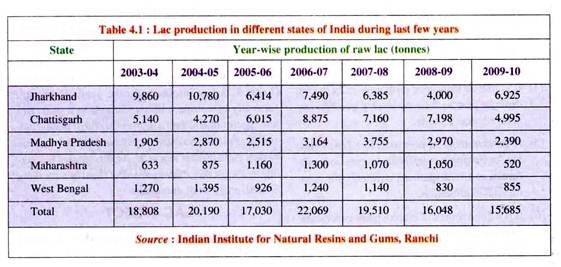In this article we will discuss about Lac:- 1. Meaning of Lac 2. Distribution of Lac 3. Composition 4. Properties 5. Lac Products and their Uses.
Meaning of Lac:
Lac is a resinous exudation from the body of a typical female scale insect, which it secretes for its own protection. Lac is the only known commercial resin of animal origin and thus, is nature’s gift to mankind.
Since Vedic period, Indians, Greeks, Romans, Chinese were familiar with various uses of lac. Lac, being an eco-friendly biodegradable and self-sustaining material has also assumed profound relevance in the current universal environment awareness.
Distribution of Lac:
Lac insects thrive best on some tropical plants which are distributed in South East Asian countries. At present lac is produced in India, Myanmar, Thailand, Malaya, China and some other countries like Nepal, Japan, Srilanka, Africa, Australia, Brazil, France, West Germany, Turkey, USA, etc. In India, few years ago, cultivation of lac was carried out practically throughout the country.
ADVERTISEMENTS:
But changing socio-economic conditions have recently restricted lac cultivation in some states only. Current major lac producing states are Jharkhand, Chhattisgarh, West Bengal, Bihar, Madhya Pradesh, Eastern Maharashtra and Northern Orissa (Table 4.1). Some pockets of lac cultivation also exist in Andhra Pradesh, Punjab, Rajasthan, Karnataka, Gujarat and Uttar Pradesh.
Composition of Lac:
Major constituent of lac is resin (68%). Lac resin is thought to be a polyester complex of straight chain hydroxy fatty acid of C14-C18 carbon chain (e.g., Aleuritic acid, butolic acid), mono- and di-hydroxy acid. Other components include dye (1-2%), wax (6%), sugar, protein, soluble salts, sand, woody matter, insect body debris, etc. Lac dye is a mixture of anthroquinoid derivatives and contains erythro- laccin and laccaic acid.
Properties of Lac:
(i) Lac is soluble in alcohol and weak alkalis but insoluble in water.
ADVERTISEMENTS:
(ii) It has capacity of forming uniform durable film.
(iii) It possesses high scratch hardness.
(iv) Heat soluble, at 80°C it melts.
(v) It is good adhesive in nature.
ADVERTISEMENTS:
(vi) Ability to form good sealers, undercoat primers.
(vii) Lac has the capacity to allow quick rubbing with sandpaper without slicking or gumming.
(viii) It is non-conductive and non-toxic.
No other single resin, both natural and synthetic, possesses so many desirable properties, and so lac is also termed as Multi-Purpose Resin.
Lac Products and their Uses:
(1) Shellac:
Shellac is natural gum resin. It is non-toxic, hard, amorphous, brittle and also edible. Its colour varies from dark red to light yellow. When heated slowly, it melts at 89-90°C. It is insoluble in water, but dissolves readily in alcohol and organic acids.
It is used in fruit coating, as binder for nail varnish, mascara, as enteric coating for tablets, in manufacturing of photographic materials, in preparation of gramophone records, as sealing wax, as a filling material in the hollows of ornaments, in preparation of toys, buttons, pottery and artificial leather.
Apart from these conventional uses, being eco- friendly and renewable raw material, it is also used in industries like textile (as stiffeners), electrical (for insulation, capping, etc.), paint, aluminium, pharmaceuticals, confectionary, food processing, cosmetics, antique, etc.
(2) Dewaxed Bleached Shellac:
ADVERTISEMENTS:
This non-toxic shellac is a bit harder and brighter than other shellac. It is completely free from wax and has high gloss and excellent adhesive quality to various substrates. It can safely be used in cosmetics (hair sprays, shampoo, perfumes, lipsticks, nail polish, eyeliners, etc.), confectionary (coating of cakes, eggs, chewing gums, cheese, fruit coating), etc.
Shellac aleuritic acid is now being used in synthesis of glucose mono-aleuritate (a non-toxic, non-hemolytic water soluble compound), an isocaloric substitute for dietary tripalmitin. Aleuritic acid esters are used in plastic, fibre materials and perfume industries also.
(3) Bleached Shellac:
It is also non-toxic and physiologically harmless and thus is widely used in food industries, food packaging and allied industries. It is also used in binding and adhesive drying-related works.
Besides, it can also be used in industries related with flexographic printing, confectionary, stamping ink, coating for processed food and dry flowers, textiles; cosmetics, wood finishing, fireworks and pyrotechnics (as binder for fireworks, match sticks etc.), grinding wheels, rubber and plastic, electronics, etc.
(4) Lac Wax:
Lac wax is a mixture of higher alcohols, acids and their esters. It can be used in preparation of polishes to be applied on shoes, floor, automobiles, etc. It is also used in food and confectionary, drug tablet finishing, crayons, lipsticks, etc.
(5) Lac Dye:
Lac dye is traditionally used to colour wool, silk, food and beverages. Being eco- friendly in nature, it is nowadays used as a colouring material. Its demand has made it rival to other synthetic colouring agents.
